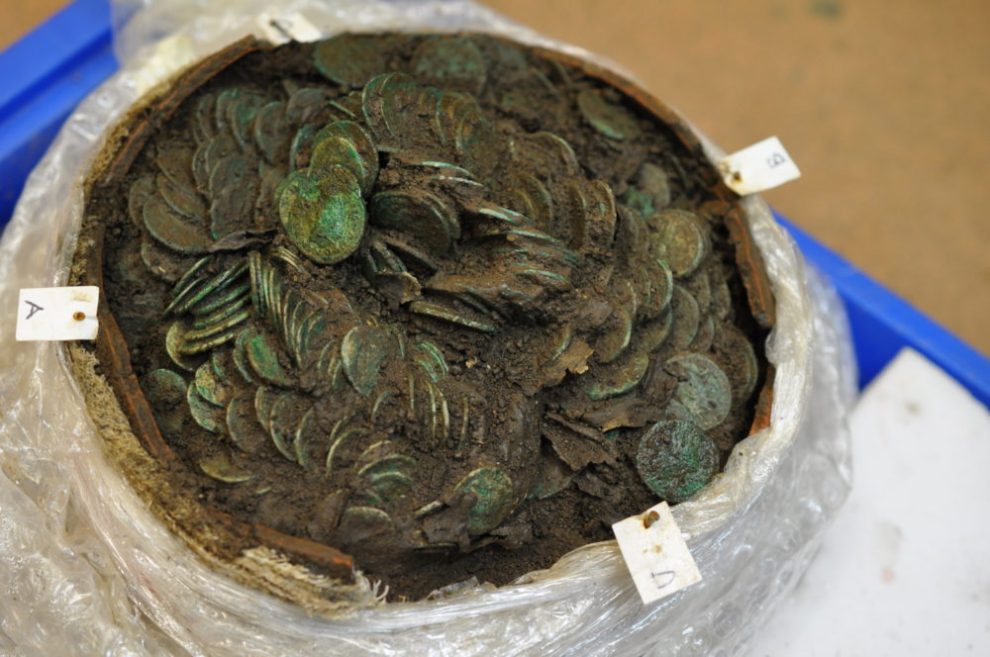The Assistant Coroner for North Wales (East & Central), Kate Robertson, has officially declared the two Roman coin hoards, unearthed by metal-detector enthusiasts in the Conwy Valley, as “treasure.”
During the winter of 2018-2019, David Moss and Tom Taylor made these remarkable discoveries in Caerhun Community, Conwy.
The larger hoard (Treasure Case 19.01) was located inside a ceramic container, containing a total of 2,733 coins. This assortment included silver denarii minted between 32 BC and AD 235, as well as silver and copper-alloy radiates, also known as antoniniani, struck between AD 215 and 270. The copper-alloy coins appeared to have been placed loosely in the pot, while the majority of silver coins were stored within two leather bags situated at the very top of the hoard.
The smaller hoard (Treasure Case 19.03) consisted of 37 silver denarii, spanning from 32 BC to AD 221. These coins were discovered scattered across a small area in close proximity to the larger hoard.
Inspired by an episode of the TV program Time Team, where a similar discovery was made, they meticulously excavated the pot. Subsequently, they carefully wrapped it in bandages before reporting both hoards to Dr. Susie White, the Finds Officer for the Portable Antiquities Scheme in Wales (PAS Cymru), who is based at Wrexham County Borough Museum & Archives.
David Moss said: “We had only just started metal-detecting when we made these totally unexpected finds. On the day of discovery, just before Christmas 2018, it was raining heavily, so I took a look at Tom and made my way across the field towards him to tell him to call it a day on the detecting, when all of a sudden, I accidentally clipped a deep object making a signal. It came as a huge surprise when I dug down and eventually revealed the top of the vessel that held the coins.”
“People do not realise the amount of work that goes on behind the scenes at the national museum, from excavating the coins, to looking after them and identifying them so they can be reported on as treasure……. it’s a huge process to be able to see the work unfold……to be involved at first hand as finders is an incredible experience.”
Subsequently, the hoards were transported to Amgueddfa Cymru – Museum Wales for a meticulous micro-excavation process and for the purpose of identification.
Louise Mumford, the Senior Conservator of Archaeology at Amgueddfa Cymru, said: “In the conservation lab, investigation at the top of the pot quickly revealed that some of the coins had been in bags made from extremely thin leather, traces of which remained. It is very rare for organic materials such as this to survive in the soil.
“The surviving fragments, which included two fragments of a stitched seam, were preserved and will provide information about the type of leather used and how the bags were made.”
The examination of the larger hoard through scanning did not reveal any additional bags within the pot, a finding that was confirmed when the pot was eventually emptied. During the micro-excavation of the hoard, a set of photographs and 3D models were created, intended for use in further research, publications, and public displays.
As the coins were progressively removed in layers, it became apparent that the older coins tended to be closer to the bottom of the hoard, while the more recent ones were found in the upper layers. This suggests that the hoard was likely buried around AD 270, a period when the Roman Empire was divided between the Central Empire and the Gallic Empire, which included Britain.
The final coins within this hoard were issued during the reigns of Quintillus (AD 270) and Victorinus (AD 269-271).
Alastair Willis, the Senior Curator for Numismatics and the Welsh Economy at Amgueddfa Cymru, remarked, “The coins in this hoard seem to have been collected over a long period of time. Most appear to have been put in the pot during the reigns of Postumus (AD 260-269) and Victorinus (AD 269-271), but the two bags of silver coins seem to have been collected much earlier during the early decades of the third century AD.”
It is likely that the smaller hoard was buried during the AD 220s. These two hoards were discovered in close proximity to the remnants of a Roman structure that was excavated in 2013. This structure was identified as a potential temple from the third century AD.
The discovery of these hoards strongly reinforces this hypothesis. It is highly probable that these hoards were placed here due to the religious significance of the site, possibly as offerings in a votive manner or for secure storage under the protection of the temple’s deity. It’s conceivable that the coins may have belonged to the soldiers stationed at the nearby Roman fort of Canovium, situated in the vicinity of Caerhun.
Llandudno Museum holds collections originating from the Canovium fort and is eager to acquire these two significant hoards, with the assistance of Conwy Culture Centre and Amgueddfa Cymru.
Dawn Lancaster, Director of Amgueddfa Llandudno Museum, remarked: “This is very exciting news for Amgueddfa Llandudno Museum. The opportunity to purchase these important coin hoards which are associated with Kanovium Roman Fort will allow future generations to see and experience a significant collection of ancient silver coins dating from 32BC and representing 50 rulers.”
“Llandudno Museum holds all previous finds from the excavation of Kanovium Roman Fort sited at Caerhun in the Conwy valley, so it is fitting the hoard is put into context along with the rest of the artefacts. Working with Amgueddfa Cymru we can share the story of their discovery and the importance to Welsh cultural heritage of our area these amazing finds represent.”



















